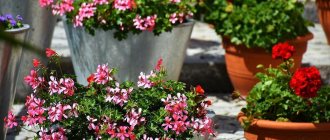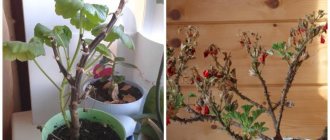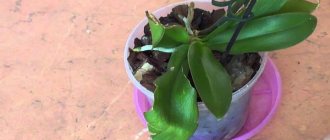Geranium has a very pleasant aroma and is characterized by decorative and even antibacterial properties. It can be grown both indoors and in open ground, if we are talking about the warm period of the year. It is relatively easy to care for, but there are problems - geranium leaves turn white. What are the reasons for this phenomenon and how to deal with it?
When and how can pelargonium leaves lighten?
In healthy pelargonium, the color of the leaf blade has a light or dark green tint (depending on the variety). This appearance is the norm. Sometimes there is a complete or partial lightening of the color; the cause may be unsuitable conditions, errors in care or illness.
The appearance of white leaves is a bad sign
Most often, symptoms appear in winter. At this time, it is most difficult to provide the flower with the necessary amount of light and optimal air humidity. In this case, the leaves may not only turn white, but also turn yellow. Problems associated with nutrient deficiencies can occur at any time of the year.
Additional Information! Leaves may turn white only at the edges or in the central part of the plate. Sometimes small pale spots appear. Measures are taken depending on the color and degree of damage to the flower.
Why did the leaves turn white?
Why does the color of the leaves lighten and they become pale? Like any plant, geranium reacts to disturbances in care. In particular, due to prolonged exposure to elevated temperatures, geranium leaves turn white. Changes in crown pigmentation usually occur in the summer.
The air temperature near the window on hot sunny days is many times higher than outside. Therefore, if the plant is located on a windowsill, it may suffer heat stroke.
As a result, geranium leaves grow completely discolored. Also, the existing healthy crown may gradually lose color and turn pale. The entire leaf, or just its border, becomes colorless. This is due to the fact that the production of chlorophyll is disrupted.
Errors in care
Why do the leaves of indoor roses turn yellow and cobwebs appear?
Unsuitable conditions and failure to follow care instructions can affect the health of the flower. Reasons for the appearance of light colored leaves:
- Lack of sunlight. Low light can cause leaf color to lighten or completely white leaves to appear. This problem is especially acute in winter.
- Lack of nutrients. Depleted soil and lack of fertilizing can cause not only lightening of the leaves, but also a slowdown in growth. It is important to regularly feed your indoor flower during flowering in the summer. The most common symptom is lightening of the leaf edges.
- Excessive feeding. Not only a deficiency, but also an excess of nutrition is harmful to pelargoniums. Frequent application of fertilizers is simply dangerous.
- High temperatures. Too warm and dry climate harms flowers. In winter, heating radiators dry out the air, having a negative effect on the plant.
Having assessed the listed factors, you can find the reason why geranium leaves lighten. Once a problem is identified, action should be taken immediately.
Even one white leaf is a signal to take action
Features of indoor flower growth, including in summer
Geraniums can bloom all year long if they receive enough light. This can be achieved by placing it on the south side of the apartment. A comfortable temperature for geraniums in winter is not lower than 10 degrees.
To maintain a beautiful, lush crown, you need to regularly pinch new shoots, trim and remove faded inflorescences. In the fall, the plant is thoroughly pruned. In spring, for active flowering, it is necessary to pinch the top.
In summer, the plant needs abundant watering as the soil dries out. Overwatering leads to rotting of the soil. The soil must have drainage for air circulation.
The optimal soil composition is a mixture of equal proportions of soil, humus and sand. Mineral fertilizers are best suited for feeding geraniums.
Diseases
Sometimes the lightening of the color of the leaves appears simultaneously with the appearance of a light coating on their lower part. This is a signal of fungal development. The reason is excessive watering or the transfer of the disease from other plants in the apartment.
Why do the leaves of indoor roses turn yellow at home?
In this case, the flower should be treated. Complex treatment with drugs is carried out. In case of a severe stage of the disease, a transplant is carried out with a complete replacement of the soil and container.
Note! During recovery, the flower is isolated from other plants.
After the flower has fully recovered, the watering regime must be strictly observed. Otherwise, the disease may return and lead to disastrous consequences, and it will be more difficult to fight it.
What to do if the plant turns pale - detailed instructions
To restore the leaves to a healthy appearance, you must follow these recommendations:
First of all, it is important to ensure a sufficient flow of oxygen for the plant: remove it from the sun, ventilate the room, and take it out into the fresh air. After just a couple of weeks, you will notice that the light leaves have gradually begun to “come to life.”- To solve the problem of insufficient lighting in the summer, you need to place the flower on the sunny side or on the balcony. However, you should avoid direct sunlight. They can cause burns and yellowing of the leaves. In winter, geraniums can be illuminated with special lamps.
There is a proven method for saturating the soil with iron. Rusty nails are buried in a pot with a plant. The main thing is the presence of rust, which can be cleaned off from rusty objects and added to the ground.
- In order not to overload the soil with fertilizers, they must be used in strict accordance with the instructions. If the composition of the soil is already damaged, then it is better to replace it with a new one. The new soil should be light and moisture-permeable.
- When controlling pests, it is important to choose the appropriate product. Repeated spraying will be required, as well as removal of infected parts. If the treatment does not bring visible results, then it is better to get rid of the flower so that healthy specimens do not become infected.
How to help pelargonium and what to do with white leaves
You need to figure out why geranium leaves turn white and what to do about it. The nature of the measures that need to be taken depends on the cause of the color change. If there is a lack of light, move the pot to a bright windowsill; if there is low humidity and high temperature, find a cool place and place a tray with expanded clay next to it. The problem with fertilizing can be solved by increasing the frequency of their use or temporarily abandoning them. White leaves are not viable, and also spoil the appearance of the plant, so they are carefully removed.
Diagnosis of the problem
Often during hot periods, housewives notice whitened leaves on geraniums. They may gradually lose color, or grow white. The production of chlorophyll is disrupted . In some cases, the leaves turn white only at the edges, while the center remains green. It may also be that white spots appear, and the surface of the leaf becomes limp and wrinkled (read about why spots appear on geranium leaves and how to cope with the problem, and from this article you will learn about why the leaves of the plant curl ).
Prevention
The best prevention of any diseases and deterioration in the appearance of pelargonium is strict adherence to the rules for the care and maintenance of the plant. That means:
- compliance with the watering and fertilizing schedule;
- maintaining optimal levels of temperature and humidity;
- ensuring sufficient lighting.
It is enough to follow simple rules for the full development of pelargonium
One of the problems that owners of pelargoniums may encounter is changes in leaf color. At the same time, an analysis of the conditions of the flower is carried out in order to understand why the leaves of geraniums turn pale. This is usually caused by errors in maintenance or as a consequence of diseases. Timely measures will help restore the plant to a healthy appearance and allow it to fully develop.
Preventive measures
Prevention includes not only the prevention of identified problems. For the best result, prevention of leaf whitening must be carried out in conjunction with other supporting measures. Then the process of healing the plant will go much faster.
Preventative measures include:
- creating optimal temperature conditions;
- sufficient lighting;
- ensuring normal soil moisture;
- drainage should prevent stagnation of water;
- creation of high-quality substrate;
- control in the use of fertilizers;
- regular inspections for damage and stains;
- removal of affected and dried areas.
There are many diseases that can ruin the beauty of geraniums. And you can recognize them by the color and texture of the leaves: they can turn red, turn yellow, curl or wither. However, if you know why they appeared and eliminate their causes in time, the flower will decorate any space with its bright colors for a long time, be it an apartment, a house or even a garden plot.
To maintain long-term flowering of geraniums, it is necessary to monitor emerging problems in a timely manner. It is also important to take into account the general condition of the plant, which affects its resistance to various diseases. In order for geranium to please the eye for a long time, you need to provide it with proper care. Then she will be able to quickly restore her vitality, and you will enjoy the lush and healthy crown of your pet all year round.
Causes of whitening of geranium leaves - a detailed description of the causes and methods of treatment
Geranium has a very pleasant aroma and is characterized by decorative and even antibacterial properties. It can be grown both indoors and in open ground, if we are talking about the warm period of the year. It is relatively easy to care for, but there are problems - geranium leaves turn white. What are the reasons for this phenomenon and how to deal with it?
Diseases
Geranium is susceptible to diseases such as chlorosis, root rot and rust. The fungal disease rust is considered the most dangerous and, unfortunately, the most common. The first signs of this disease are many small spots of yellow or light brown throughout the leaf part. After a short time, these stains become dry and, when cracked, crumble into a rust-colored powder. This is what fungal spores look like, which can destroy an entire geranium bush. If assistance is not provided in a timely manner, the plant first loses its leaf part and then dies completely.
To save a plant from a harmful disease, it is recommended:
- Trim off all diseased parts of the plant;
- Treat the indoor crop with the most suitable fungicide.
Before using chemicals, you must carefully read the instructions!











